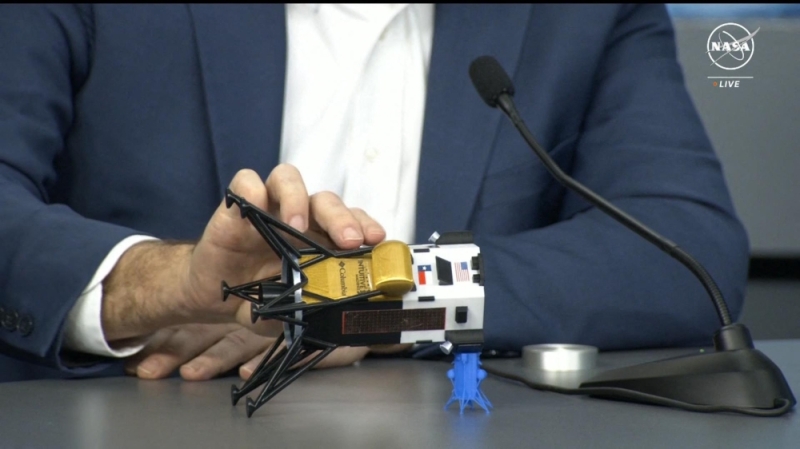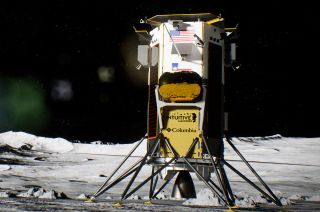Odysseus moon lander may have tipped over, NASA partner says
Officials are still trying to get photos from the moon's surface.
ByGio Benitez and Ivan Pereira
February 23, 2024
As the world waits for Odysseus to send its first images from the moon's surface, officials announced Friday afternoon that the moon lander may have had a misstep.
Intuitive Machines, the private Houston company that partnered with NASA, said Friday that they believe "Odie" hit a rock as it was landing and tipped over.

In this photo courtesy of Intuitive Machines, Odysseus passes over the near side of the Moon
Intuitive Machines/AFP via Getty Images
The majority of the lander's payloads are working and Odie, which is solar-powered, has 100% battery power, according to the company.
MORE: Odysseus moon landing updates: Nova-C makes first successful commercial lunar landing
Odysseus is the first U.S.-based craft to land on the moon in over 50 years. It also marked the first commercial based landing on the moon in U.S. history.
The craft launched last week from NASA's Kennedy Space Center in Florida and entered lunar orbit Wednesday before it descended and landed on the moon's surface.
MORE: Video Odysseus makes historic successful moon landing
Although the lander has not sent any images from the moon's surface as of Friday evening, Intuitive Machines released one image that was taken while they had access to Odie's camera during the flight.

Intuitive Machines released this image after they said Odysseus tipped over, Feb. 23, 2024.
Intuitive Machines
The image was taken about six miles above a crater near the south pole of the moon, and about 124 miles from its landing site, according to the company.
The lander is carrying five NASA instruments, including a radio beacon meant to transmit precise geolocation and cameras that capture how the surface of the moon changes from interactions with the engine plume of the spacecraft, as well as commercial cargo.
US spaceship lying sideways after dramatic Moon touchdown
WASHINGTON, Feb 24 — The first American spaceship to the Moon since the Apollo era is probably lying sideways following its dramatic landing, the company that built it said yesterday, even as ground controllers work to download data and surface photos from the uncrewed robot.
The Odysseus spacecraft landed near the lunar south pole Thursday at 6:23 pm Eastern Time (2323 GMT), after a nail-biting final descent when ground teams had to switch to a backup guidance system and took several minutes to establish radio contact after the lander came to rest
Intuitive Machines, the company behind this first-ever lunar landing by a private company, initially posted on social media that its hexagonal spaceship was upright, but CEO Steve Altemus told reporters yesterday that statement was based on misinterpreted data.
Instead, it appears that it caught a foot on the surface and tipped over, coming to rest horizontally with its top perched on a small rock — taking some shine off an accomplishment widely hailed as a historic achievement.
A Nasa probe called the Lunar Reconnaissance Orbiter should be able to photograph Odysseus over the weekend, helping pinpoint its exact location.
Altemus said that while solar arrays were on the top-facing side, the team’s ability to download data from the science experiments on board was being hampered because of antennas facing downward that “are unusable for transmission back to Earth — and so that really is a limiter in our ability to communicate and get the right data down so we get everything we need for the mission.”
Because of complications associated with the landing, a decision was taken not to shoot out an external camera to capture the descent as it happened, according to Embry-Riddle Aeronautical University, which built the “EagleCam” device.
But the team will still attempt to deploy it from the ground to try to obtain an outside image of Odysseus.
Improvised fix
Odysseus is still considered the first success for a new fleet of Nasa-funded lunar landers designed to carry out science experiments that will pave the way for the return of American astronauts to the Moon later this decade, under the Artemis programme.
A moonshot by another American company last month ended in failure, raising the stakes to demonstrate that private industry has what it takes to repeat a feat last achieved by US space agency Nasa during its manned Apollo 17 mission in 1972.
Underlining the technical challenges, Intuitive Machines’ own navigation technology failed and ground engineers were forced to jury-rig a solution, hastily writing a software patch to switch to an experimental Nasa laser guidance system that was intended to run only as a technology demonstration.
Altemus later revealed Odysseus’ own laser system failed to turn on because someone had forgotten to flip a safety switch before takeoff, which he described as “an oversight on our part.”
Confirmation of landing was supposed to come seconds after the milestone, but instead around 15 minutes passed before a faint signal was detected, enough to declare the spaceship was in one piece and had met its goal.
Commercial Moon fleet
Nasa paid Intuitive Machines US$118 million (RM563.7 million) to ship six experiments under an initiative which delegates cargo services to the private sector in a bid to achieve savings and stimulate a wider lunar economy.
Odysseus also carries cargo for private customers, including a reflective heat wrapping developed by Columbia Sportswear and used to protect the spaceship’s cryogenic propulsion tank.
The United States, along with international partners, want to develop long-term habitats on the south pole, harvesting ice there for drinking water — and for rocket fuel for eventual onward voyages to Mars.
The first crewed landing under Nasa’s Artemis programme is set to take place no sooner than 2026. China meanwhile plans to put its first crew on the Moon in 2030, opening a new era of space competition.
The mission was the fourth attempt at soft lunar touchdown by the private sector. Intuitive Machines joins the national space agencies of the Soviet Union, United States, China, India and Japan in an exclusive club of landing on the Moon.
— AFP
U.S. lands on moon in historic feat for private spacecraft
, Bloomberg News
An American-made lander touched down on the moon for the first time since the Apollo era, ending a string of failures and making it the first private spacecraft to ever reach the lunar surface intact.
The lander, built by Houston-based Intuitive Machines Inc., reached the moon at 6:23 p.m. U.S. East Coast time on Thursday. After a brief communications blackout, flight controllers acquired a signal and confirmed the robotic craft, nicknamed Odysseus, was upright and starting to send data.
The success follows a series of missteps by private groups looking to land on the moon and bodes well for Intuitive’s aim of creating a business ferrying payloads and experiments there. It’s hoped the landing will provide an up-close look at the moon’s south pole region and offer NASA new information as it aims to return humans to the lunar surface.
The closely watched mission marks the first time a U.S.-built spacecraft has made it to the surface in one piece since 1972, when NASA was carrying out the Apollo program.
“Today for the first time in more than a half century, the U.S. has returned to the moon,” NASA Administrator Bill Nelson said in a webcast. “Today is a day that shows the power and promise of NASA’s commercial partnerships.”
Three other private-sector entities have unsuccessfully attempted to softly place landers on the moon since 2019. In January, a company called Astrobotic had to forgo the landing of its vehicle after an engine mishap in space crippled its chances.
Intuitive Machines also overcame difficulties throughout its mission. Prior to landing, lasers on Odysseus designed to navigate the moon’s terrain weren’t working properly, so Intuitive Machines had to switch to a NASA lidar instrument. The company sent the lander on an extra lap around the moon to upload a software patch to boost the lidar’s capability.
“I know this was a nail-biter, but we are on the surface and we are transmitting. Welcome to the moon,” Intuitive Machines Chief Executive Officer Steve Altemus said in the webcast.
Shares of Intuitive Machines soared on news of the successful landing, rising 44 per cent as of 8:10 a.m. Friday in New York. The stock had already more than tripled this year through Thursday’s close, valuing the company at about US$800 million.
“This validates the company’s technology and adds significant credibility to the business,” Andres Sheppard, an analyst with Cantor Fitzgerald, said in a note. “Intuitive Machines is now very well positioned to continue to capitalize on the growing commercial space economy, and on subsequent launches.”
The startup and Astrobotic were both partially backed by NASA, which is seeking to further explore the moon as part of its Artemis program. The U.S. space agency’s goal is develop a sustainable presence on and around the moon, to learn how to live off of other worlds.
Intuitive Machines holds contracts with NASA to deliver two additional landers to the moon’s surface in the coming years. NASA paid a little less than $118 million to Intuitive Machines for this mission, up from an original contract amount worth $77 million awarded in 2019.
“We learn from the successes and the failures of the past and stand on all those shoulders to try to be successful,” Altemus said in an interview before the landing. “And the key here is to be undeterred.”
The lander launched on top of a SpaceX Falcon 9 rocket on Feb. 15 and reached the moon’s orbit six days later. On this trip, the company is carrying six payloads for NASA and five from commercial customers, including sculptures from artist Jeff Koons.



No comments:
Post a Comment